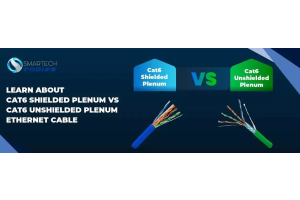How Temperature Affects Your Ethernet Cables

Temperature affects everything and ethernet network cables are not an exception. The question however is, how does temperature affect ethernet cables? Extremely hot temperatures can have a certain effect on networking cables and cold temperatures can have a different impact.
In this article, we will discuss the different ways how temperature affects bulk ethernet cables.
Does temperature affect ethernet cable performance?
As stated earlier, yes indeed, temperature affects ethernet cables. The conductors in cables are made from metals, which are prone to be affected by a significant rise or decline in the temperature of the environment.
The environmental temperature not only affects the performance of the cables but also affects the installation process. If you are installing your cables in very hot weather, the cables will become too soft and will not pass through tight spaces. And if the weather is too cold in the area where you are installing the cables, they will get too stiff, and again, you will have a hard time installing them.
The effects of temperature on ethernet cables are many and it is necessary to make sure you maintain the climate of the spaces where you are installing the cables.
Also Read: Top Tips for Protecting Your Ethernet Cables
Affects on attenuation
To state simply, attenuation is the ratio of the input power and the output power. It is measured in decibels (dB). It is also known as ‘ping’ nowadays.
A healthy or efficient ethernet connection should have a balanced ratio of attenuation. Meaning, the input and output signals should be equal or in other words, if a connection is fed a certain amount of signals on one end, the other end should deliver the same amount of signals. Unfortunately, it is not always the case. And this phenomenon is called attenuation.
Now, no mechanical system can be 100% efficient but the more balanced the ratio, the better the performance of the connection.
With the rise in temperatures, attenuation in ethernet cables also rises. This means, in warm climates, your ethernet cables might not perform as efficiently as they can.
In low temperatures also, attenuation is higher. And you can enhance the performance of your cables by putting in just a little effort at insulating them.
To help you better understand, here’s an example.
This Cat6 Plenum Cable can be installed very easily in temperatures between 32°F - 140°F. It can also perform at optimum capacity in this temperature range. However, if you need to install it in a place where the weather can get colder or hotter than this temperature, you should consider insulating the cable. We will discuss different techniques of protecting ethernet network cables in the end.
Affect on data transfer speed and bandwidth capacity
The effects of temperature on data transfer rate and bandwidth are important to understand. Some people believe that the speed of ethernet cables increases in higher temperatures. That is not true. For example, if you expose your cables to temperatures of say, 250°F, they will perform poorly, not to mention the risk of a fire hazard.
Bulk ethernet cables, therefore, come with a recommended application temperature, which is the same for almost all cables 32°F - 140°F (0°C to 60°C). If you want your cables to perform at their optimum capacity, make sure you maintain the temperatures within recommended level.
There’s one exception. At cold temperatures, your cables may lose their peak performance capacity but the difference will be unnoticeable. That is due to the cable’s tendency to heat up while transferring data.
Affect of on EMI and crosstalk/noise in Ethernet Cables
Effect of temperature on EMI, crosstalk, and other types of interferences in ethernet cables is also a significant matter. At high temperatures, the electrons in the conductor metal can move more freely which can translate into increased crosstalk and external noise. Similarly, at low temperatures, the same interferences will be reduced due to less mobility of the electrons in the conductor.
EMI is not much affected by varying temperatures per se. However, an extremely hot or cold climate can certainly affect electromagnetic interference (EMI) in a cable. But it can be very small and hence, unnoticeable.
How to protect ethernet cables from extreme temperatures?
- Get shielded cables such as this Riser-rated Cat6A. They come with built-in insulation.
- Use external cable insulation materials where ethernet cables are exposed, particularly outdoors.
- Install cables in spaces with moderate temperature, if possible.
- Keep track of temperatures in the places where you run your cables to promptly respond.
- For high temperatures, install heat shields around the cable.
Conclusion
Temperature affects ethernet network cables in various ways. It is important to take care of it to get optimum performance from your cables. The most effective way of protecting ethernet cables from extreme temperatures is to buy the best cables. They are easier to insulate and can withhold hot and cold weather easily. SmarTech Cables is the industry leader in manufacturing cables and accessories.






